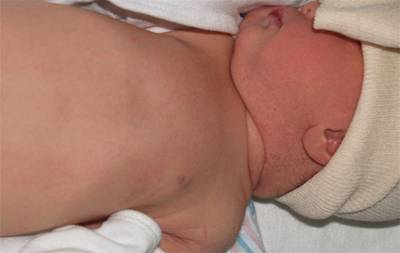Please note that some guidelines may be past their review date. The review process is currently paused. It is recommended that you also refer to more contemporaneous evidence.
Neonates are susceptible to bleeding for various reasons. Take a detailed history, physical examination and determine whether the neonate is 'well' or 'sick'. Reasons for bleeding in neonates include:
- immaturity of the haemostatic system because of quantitative and qualitative deficiency of coagulation factors
- maternal disease and medication use
- birth trauma
- other conditions such as sepsis and asphyxia.
Clinical presentation of neonatal bleeding
Bleeding in neonates may present with:
- oozing from the umbilicus or stump
- cephalhaematoma
- bruising more than anticipated after birth
- bleeding from peripheral venipuncture or procedure sites
- bleeding into scalp
- bleeding following circumcision
- petechiae
- intracranial haemorrhage
- bleeding from mucous membranes
- unexplained anaemia and hypotension.
Particular points in the history include:
- maternal diseases such as idiopathic thrombocytopenic purpura (ITP) pre-eclampsia and diabetes
- maternal exposure to drugs such as aspirin, anticonvulsants, rifampicin and isoniazid
- family history of bleeding disorders
- previous affected siblings
- confirmation of vitamin K administration.
 Figure 1: Newborn with petechiae on the face and thorax
Figure 1: Newborn with petechiae on the face and thorax
Source: Stanford University
Differential diagnosis of neonatal bleeding
Physical examination will determine whether the neonate is 'well' or 'sick'. This is very useful as the differential diagnosis is different in the two circumstances.
Causes of bleeding in a 'well' neonate:
- immune thrombocytopenia
- alloimmune (NAIT) or autoimmune (maternal ITP)
- vitamin K deficiency
- inherited coagulation factor deficiencies such as haemophilia
- bleeding from anatomic lesions such as a haemangioma, A-V malformation.
Causes of bleeding in a 'sick' neonate:
- disseminated intravascular coagulation (DIC) - usually associated with sepsis, asphyxia, severe respiratory distress syndrome (RDS) or necrotising enterocolitis (NEC).
- consumption thrombocytopenia without depletion of coagulation factors
- liver failure.
Bleeding at a single site is more likely to have an anatomic or structural component.
Major bleeding from any primary cause may induce a secondary DIC, which may mask the original pathology.
Laboratory investigations
First line tests include:
- platelet count
- APTT
- PT
- fibrinogen
- d-dimer.
The results should be interpreted in the context of normal laboratory values for gestation and postnatal age.
Interpretation of laboratory investigations in a bleeding neonate
Isolated prolonged APTT, consider:
- factors XII, IX, XI and VIII deficiencies
- heparin
- early DIC.
Isolated prolonged PT, consider:
- early DIC
- liver disease
- vitamin K deficiency
- factor VII deficiency.
Combined prolonged APTT and PT+/- low fibrinogen, consider:
- DIC
- liver disease
- vitamin K deficiency
- rarely inherited factor deficiency such as prothrombin deficiency.
Normal APTT, PT, platelet count, fibrinogen, consider:
- factor XIII deficiency
- platelet function defect
- A-V malformation
- severe neutropenia (bleeding from umbilical stump).
Other points to consider:
- Von Willebrand disease rarely presents in the newborn period.
- Factor XII deficiency causes a prolonged APTT, but no clinical bleeding.
Management of neonatal bleeding
Management depends on the cause of bleeding and clinical condition of the neonate. Specific management includes the following.
DIC
- Treat the primary condition.
- Blood products (platelets and FFP) are used on clinical grounds.
- 10-15 mL/ kg of FFP can be given to correct coagulation abnormality. If platelets < 50 and actively bleeding, transfuse platelets.
Vitamin K deficiency
- IV vitamin K1, 1 mg is usually effective within hours.
- Also give FFP 10-15 mL/kg immediately.
- Increase the levels of clotting factors.
Inherited factor deficiency
- Initial therapy with FFP after blood taken for specific factor assays.
- Specific factor replacement when diagnosis known.
More information
Consult a paediatric haematologist at the Royal Children’s Hospital if in doubt. Tel (03) 9345 5522.
Related information
- Thrombocytopenia
- Respiratory distress syndrome (RDS)
- Necrotising enterocolitis (NEC)
- Sepsis
- Normal laboratory values
Further reading
- Christensen, MD: Hematologic problems of the neonate. W.B. Saunders Company, first edition; 2000.
- Simon J Stanworth, Thrombocytopenia, bleeding, and use of platelet transfusions in sick neonates.
- Ash Education book December 8, 2012 vol. 2012 no. 1, 512-516
Contact us
Version history
First published: 2013
Review by: October 2018

